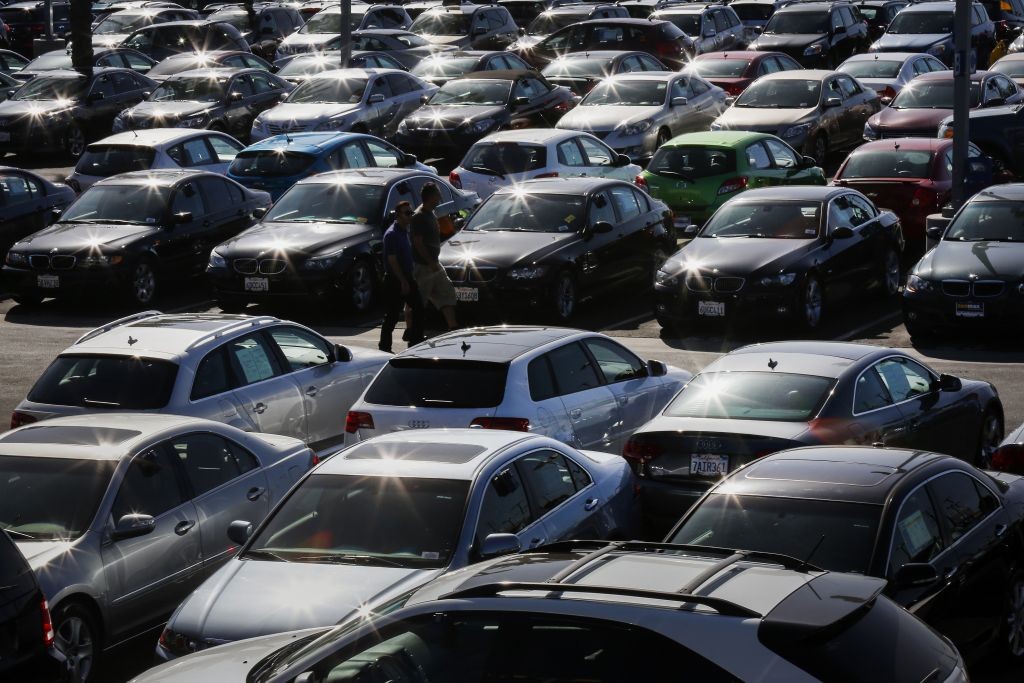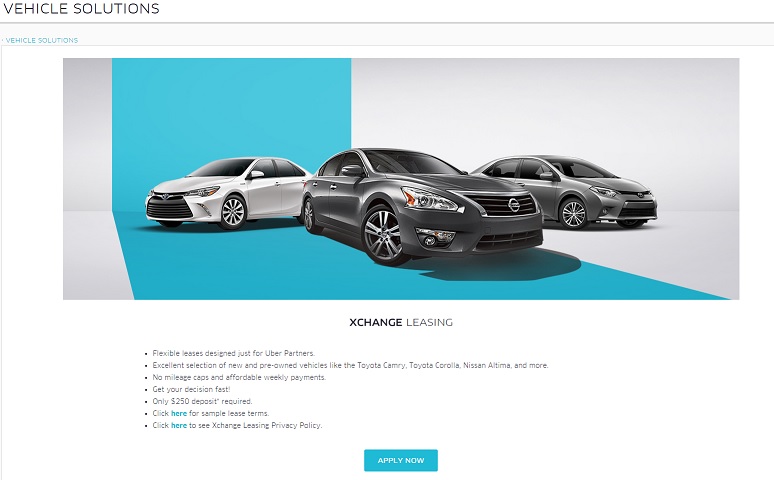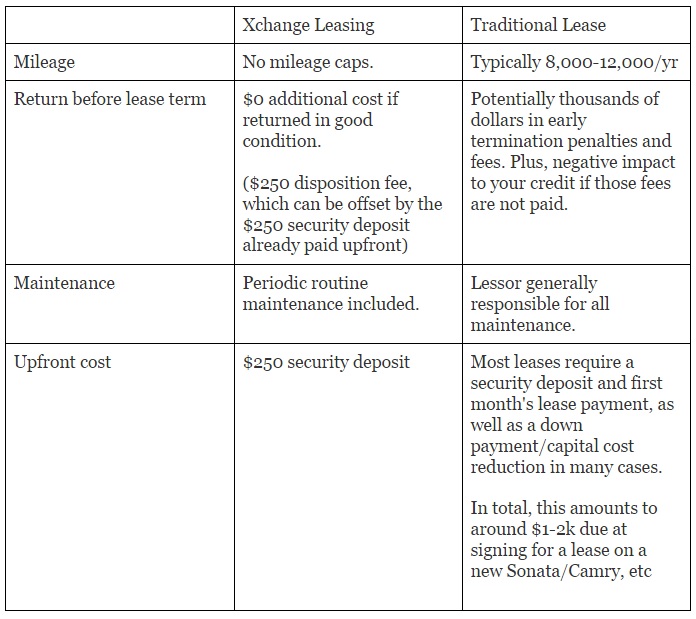Harry here. We’ve gotten a lot of questions about the Xchange Leasing Program, so today, RSG contributor Christian Perea re-visits this program now that it’s been live for a few months to see what drivers are saying about it and what their experiences have been like leasing a car.
The new leasing program available for Uber rideshare partners actually is a pretty beneficial one for drivers, but getting the best deal from a dealership has been a challenge. So we gathered feedback from drivers who went through the process to help you learn more about the pain-points and how to avoid them.
If you’re looking for a comprehensive list of all the leasing/rental options available for rideshare drivers, please check out our new Uber and Lyft Vehicle Marketplace page.

A few months ago, Uber launched its Xchange Leasing Program and we wrote an article reviewing how it stood to change the leasing market for rideshare drivers. Previous leasing options were costing drivers up to two or three times as much per week and limiting their mileage with steep overage fees.
On the surface, the Xchange program seemed to address a lot of those concerns, offering flexible terms, free maintenance and even unlimited mileage. Now that a few months have passed, we wanted to re-visit this topic and see what kinds of deals drivers are getting and offer advice for actually leasing the car from a dealership.
I went back and talked to drivers about their experience and worked in conjunction with Xchange Leasing to review what the most common questions and pain-points were with this program. We found that many of you were able to get approved pretty easily but had run into a roadblock at dealerships. This article will address those concerns and more.
In future articles, we’ll take a look at the earning potential with one of these leases and compare it to other available options. Who knows, we may even get one of these leases ourselves and try it out!
Before I tell you what to expect and how to be prepared to deal with dealership shenanigans, catch up on a brief recap below.
A Quick Recap: What is Xchange Leasing?
The Uber Exchange Leasing Program is a subsidiary company (basically owned and operated by Uber) of Uber’s that offers a financial product to get Uber drivers into cars. They do this by approving new and existing drivers for their leasing terms and then sending them to local dealerships with financing in hand.
Xchange Leasing assumes the risk of the lease, and the driver pays Xchange Leasing via their Uber Earnings or traditional payment methods.
Let’s take a quick look at the features of the Uber Xchange Lease:
- Unlimited mileage – this is a big one
- Lease as low as $98.00/week (for a pre-owned vehicle, plus taxes and fees)
- Decent range of vehicles, including some that are eligible for UberXL
- Ability to terminate the lease with just 2 weeks notice (AFTER 30 days have passed)
- Oil changes, tire rotations, and cabin air filter replacement
- Quick credit decisions
Note: Some people call it Uber Exchange Leasing Program but it’s Xchange 🙂
What Xchange Leasing Isn’t: A Dealership
Xchange Leasing is not the same as the BAMA or Santander leases; it is a separate entity and operation from Uber’s Vehicle Solutions. Just because you signed up for something under “Uber Vehicle Solutions”, that doesn’t mean you are on the Xchange Leasing program.
In fact, if you end up on one of those other leases, there is a pretty good chance you are going to spend a lot more money on your car. Xchange is listed as Xchange Leasing under the vehicle solutions tab within the Uber Partner portal.

Remember, it’s not a dealership. Xchange is merely providing the framework for you to get a car.
The Challenge: Dealership Shenanigans
The thing you’ll need to keep in mind is that once you’re approved, you are responsible for finding your own vehicle. Remember to be patient and persistent in doing so. Being impatient in getting your car will exact a hefty premium on the price you pay and your overall driving experience. A lot of the game breaks down to finding the right vehicle for you based on the availability at dealerships.
Here are some of the situations that were most common at dealerships for drivers seeking a vehicle through the Xchange Leasing program:
Dealers Telling Drivers Used Cars Do Not Qualify for That Program
One of the reasons we were excited about this program is because of the possibility of used vehicles. Since drivers are paid the same rate by Uber regardless of whether they drive a new car or an old one, you can lower your expenses with a quality used car.
But when the dealer tells you that used cars don’t qualify for the Xchange Program, what they are really saying is, “We don’t want to sell you any of our used cars because we don’t make as much money off those with Xchange Leasing”.
Remember, Xchange allows for cars that are 2010 or newer and with 60,000 miles or less. Uber will only pay 105% of the lending Blue Book value to prevent price gouging and to ensure that prices for used vehicles remain sane. There are certain used cars that the dealer may be able to fetch a higher price from someone else (i.e. used cars that they can sell for greater than 105% of the lending Blue Book value). Generally, cars that hold their value well (Honda and Toyota) will tend to sell much higher than their lending Blue Book value, and thus are much more difficult to get a hold of than used cars that don’t hold their value as well (Kia, Chevy, Hyundai).
This doesn’t mean it is impossible to get a used car from the program, though. After talking with drivers, it seemed that many had better luck when targeting used vehicles that are not native to the dealership. For example, if you are at the Toyota dealership, you might have trouble buying a used Prius, but you would be able to lease a used Honda Civic. At the end of the day, it all depends on the channel in which the dealership acquired the vehicle, and high quality used cars fetch a good price for the dealership.
Perhaps this is because those vehicles were trade-ins or more desirable for the dealership to sell. Either way, the trick seems to be finding the used car that the dealership wants to sell. In the end, you may still end up leasing a new vehicle, but make sure that you at least compare it to the cost of a used one.
Our Leases are Less Expensive than Xchange Leasing
This is partially true. Although you might think the salesperson is trying to get a higher commission by selling their own product, I tend to believe that they just don’t know how many miles we put on our cars every week. Thus, they do not realize how quickly a typical Uber driver would burn through the mileage limits on the cheaper lease and end up in a hell-hole of overage fees.
The dealership’s salesmen probably just see that $150/week adds up to $600/month and think they are saving you a lot of money. The value in Xchange Leasing isn’t the monthly payments to occasionally drive a car though; it’s turning the depreciation and maintenance into a fixed cost while having the ability to exit quickly if need be, and unlimited mileage.
Xchange Leasing Program vs Traditional Lease Program
Pay the Deposit and We Will Put You on a List
Some dealerships asked drivers to pay the $250 deposit down before deciding on a car but that usually means they just don’t have the inventory in stock right now. You should only pay the deposit once you decide on a vehicle.
A dealership might try to get you to pay the deposit before shopping around in order to lock you into whatever they give you. The simple fact is that other dealerships will not do this. Go to them.
Shopping Dealerships
Many markets offer several dealerships that Xchange Leasing has partnered with. Since each dealership is different, your experience there will be different as well.
In fact, I highly suggest shopping around several dealerships and being patient while deliberating among your choices in vehicles. You may only be able to view one dealership in your area on your list, but you can always try to get a hold of a dealership in another market that is worth the drive for a better deal. That way you can leverage one dealership against another.
From the drivers we spoke with, we found a couple dealerships where drivers were able to get very good deals. If you have suggestions for us, please leave a detailed review in the comments below about your experience, and we’ll add them to our list.
Los Angeles
Hertz Norwalk – Douglas Chin has helped answer a lot of reader’s questions in the comments section below.
Ask For The Dealership’s “Uber” Specialist
We found that some of these dealerships ended up dedicating one person who handles Xchange Leasing requests. They tend to be much more knowledgeable about the program than anyone you will run into on the lot. Try to call them first and see what is available, so you can weigh your options without leaving the house.
Success Story: RSG Reader Brad Codd
Brad ran into a lot of these issues and shared them with us as he went through the process of finding the right vehicle. He initially contacted a dealership that gave him the runaround and claimed they either didn’t have any cars available for Xchange.
But after doing some more shopping around (and going to a different dealership!) he was able to get into a 2012 Hyundai Sonata Hybrid 2012 for just $120.16 a week. He documented his experience in the comments section of our last article, and it helped point us in the right direction, so thanks to Brad.
Patience and Persistence
The overarching theme to getting a good deal is that it pays to be patient and persistent to get into a new car. Those who rushed it seemed to be the least happy while those who took their time got a much better deal and were happy with the results.
So if you’re without a car and thinking about driving for Uber, this really is the best way to try it out, in our opinion. It probably makes the most sense for full time drivers since the payments are more expensive than a traditional lease, but it also has the flexibility to get out at any time.
A lot of drivers ignore the cost of their vehicle, but with this option, all of the expenses associated with running your business are known up front. Every week, you take your earnings and subtract gas and the Xchange Leasing fee, and you know exactly how much you made that week. It doesn’t get much simpler and or more transparent than that.
If you’re brand new to Uber and you’d like to sign up for the Xchange Leasing Program, please click here. If you’re already a driver, and you want to sign up for the Xchange Leasing Program, please click here.
Drivers, what do you think about the new Uber Xchange Leasing Program? Do you have any experience with the program and navigating negotiations with dealerships? Please let us know below in the comments.
If you’re looking for a comprehensive list of all the leasing/rental options available for rideshare drivers, please check out our new Uber and Lyft Vehicle Marketplace page.
-Christian @ RSG
FAQ
How do I contact Uber Xchange Leasing?
The best way to contact Uber Xchange is to send an e-mail to support@xchangeleasing.com. For issues regarding payments, contact the payments team at 888-314-0836 or see direct payment options here.
Call center hours (all listed in Central Time): Monday – Thursday 7:00am to 8:00pm, Friday 7:00am to 7:00pm, Saturday 8:00am to 12pm
How do I return my Xchange vehicle?
The fine print says that you have to have leased it for 30 days, and you need to provide two weeks notice before you return it. Upon returning the vehicle, there is a $250.00 disposition fee. It’s worth noting that when your return your vehicle, you presently won’t be able to get another vehicle via Xchange. So make sure if you return it and plan on driving that you have another vehicle lined up.
In what cities/states are Uber’s Xchange Leasing Program available?
The program has expanded to cover most of the major markets within the US and continues to be rolled out as Xchange establishes partnerships with more local dealerships.
How does maintenance work with Xchange Leasing?
Periodic routine maintenance is included in the price of the lease and also required as part of each lease agreement. Every 5,000 miles a vehicle is due for an oil change and tire rotation. Every 25,000 miles a vehicle is due for a cabin air filter replacement. To have maintenance completed, you must visit the dealer in which the car was leased to have the maintenance completed.
How are fees assessed on the vehicle if I return it a year after rideshare driving? Will I get a big bill for damages?
Each dealership has a standard inspection form to evaluate excessive wear and tear or unexpected damages such as visible dents. Since the program has no mileage caps, excessive wear and tear is generally based on obvious damages to the car.
That being said, any damage to the car is the drivers responsibility to manage. So make sure you stay on top of maintenance and go into the dealership if a shock goes out.
Is insurance included in my Xchange Lease?
No. You have to purchase private insurance like any other lease. Check out our insurance marketplace page for TNC friendly insurance.
What is Xchange Access?
Xchange Access is the second tier of Uber’s Xchange Leasing program. Basically what it means is that you will only be able to take over someone else’s lease. So if someone returns their Xchange lease, that car is now eligible for the Access program.





